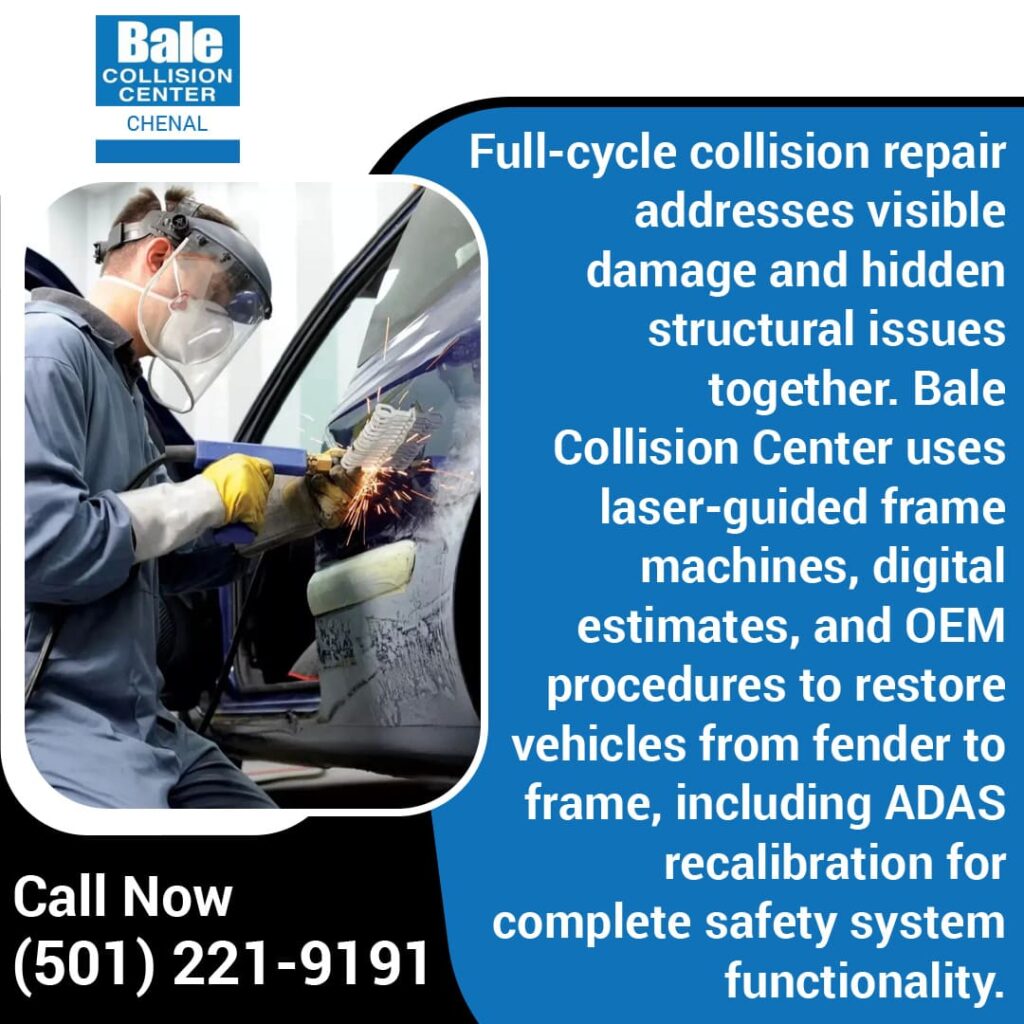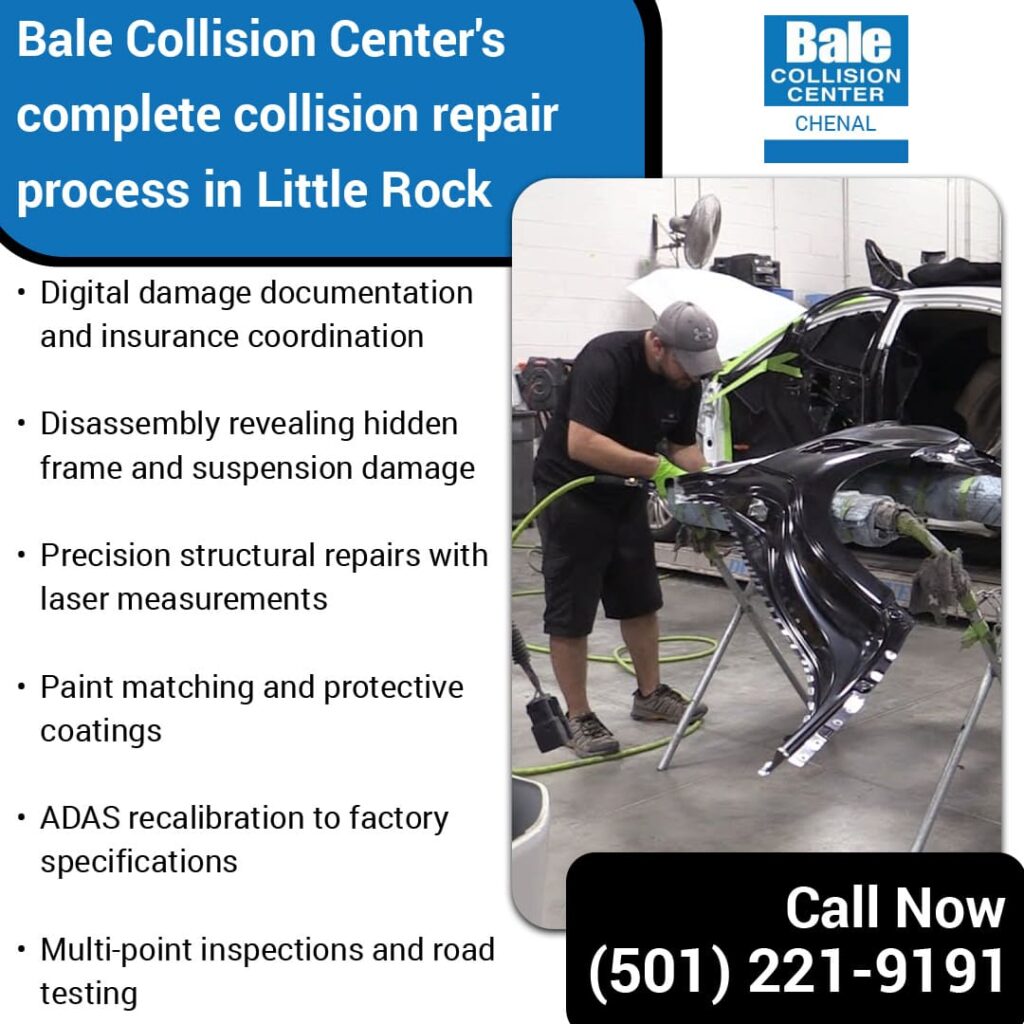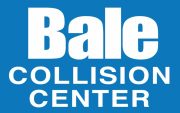When a vehicle is involved in a collision, the damage often extends beyond what can be seen on the surface. A bent fender, cracked bumper, or chipped paint may look like the main concern, but underlying structural issues, misaligned frames, or disrupted safety systems can create hidden risks. Drivers often face the challenge of finding a collision center that can address both the cosmetic and mechanical aspects of an accident in one coordinated process. Quick cosmetic fixes may restore appearance, but without a full-cycle repair approach, the vehicle may not perform as designed in terms of handling, crash protection, or airbag deployment.
At Bale Collision Center (Chenal), full-cycle collision repair means restoring every component of the vehicle, from fender to frame, to manufacturer standards. By combining structural work, paint refinishing, and advanced technology calibration in one facility, our team provides auto collision repair in Chenal Parkway, Little Rock, AR, that addresses the full scope of post-accident needs. This approach reduces delays, eliminates guesswork, and gives Little Rock drivers confidence that their vehicle is returned in safe, road-ready condition.

What “Full-Cycle” Collision Repair Means for Drivers
Full-cycle collision repair means restoring a vehicle from cosmetic damage to structural safety in one coordinated process. Drivers benefit from a repair approach that addresses both visible dents and hidden structural or electronic issues.
A Start-to-Finish Process, Not Just a Quick Fix
A start-to-finish repair process means the vehicle is restored to manufacturer standards, not just made to look undamaged. Quick fixes often focus on visible areas like paint or panels, leaving hidden issues unresolved. This can affect steering, airbag deployment, and crash protection.
At a certified collision repair center, each vehicle goes through inspection, frame restoration, surface refinishing, and electronic calibration. For example, a car with a bent frame undergoes laser-guided measurements, while a vehicle with scratched panels receives rust-prevention coatings during refinishing. These steps protect both safety and resale value.
Why One-Stop Collision Centers Reduce Stress and Delays
One-stop collision centers reduce stress and delays by handling all repair stages under one roof. When different shops manage structural, paint, and sensor repairs separately, the process slows down and increases costs. A single collision center coordinates insurance communication, parts ordering, and repair updates for the customer. For example, if a car collision repair requires both frame straightening and ADAS calibration, the work is completed in sequence without outsourcing. This approach saves drivers time while making sure the vehicle is repaired to full safety standards.
Step 1 – Intake and Estimating
Vehicle Drop-Off and Initial Walkaround
The intake process begins with a walkaround inspection to document visible damage before repairs start. At Bale Collision Center on Chenal Parkway, we take photos of each car and log them to create a baseline record. This helps us track both surface dents and alignment issues. By starting with a detailed walkaround, technicians can note areas likely to need closer review once panels are removed.
Digital Estimates and Communication with Insurers
Digital estimates give drivers a clear cost breakdown while also streamlining communication with insurance companies. At our collision center in Little Rock, technicians use estimating software to list labor, OEM parts, and paint requirements. This reduces disputes during the claims process. For example, if a fender replacement requires factory paint blending, the digital estimate includes it upfront.
Delays in claim processing often result from incomplete or inconsistent documentation. By submitting digital estimates with photos and scan results, we reduce back-and-forth with adjusters. This helps customers move from estimate to repair approval faster, while also keeping costs transparent.
Step 2 – Disassembly and Hidden Damage Checks
Why Disassembly Reveals More Than Surface Damage
Disassembly is necessary to uncover hidden damage that cannot be seen from the outside. Minor dents or scratches often conceal structural issues, bent mounting points, or misaligned panels. Technicians remove fenders, bumpers, and trim pieces to inspect the frame, suspension mounts, and internal body supports. Identifying issues early prevents long-term safety problems and reduces repair costs.
Scanning and Diagnostics for Electronics and Sensors
Modern vehicles rely on electronic systems that must be tested after a collision to ensure proper function. Advanced Driver Assistance Systems (ADAS) and other sensors can shift during impacts. At Bale Collision Center, we use diagnostic tools to scan airbags, parking sensors, lane departure cameras, and the radar module. Scanning after disassembly ensures all electronics function correctly and supports accurate frame alignment. Linking this step with structural repair allows repair shops to restore both safety and performance.
Step 3 – Structural and Mechanical Repairs
Correcting Frame Misalignment with Precision Tools
Frame misalignment is corrected using precision tools that restore the vehicle to factory specifications. At Bale Collision Center, technicians employ laser-guided measuring systems and hydraulic frame machines to reposition bent rails and mounting points. For example, a front-end collision may require adjusting frame rails and suspension mounting brackets simultaneously to maintain proper wheel alignment.
Certified collision repair centers make sure these corrections meet Original Equipment Manufacturer (OEM) standards. Properly realigned frames improve handling and reduce wear on tires and suspension components.
How Structural Repairs Affect Driving Safety
Structural repairs directly impact vehicle safety by restoring the intended crash protection and handling. A misaligned frame or damaged support structure can compromise crumple zones, airbags, and seatbelt anchor points.
Our technicians verify repairs with digital measuring tools and test-fit panels and mechanical components to confirm alignment. For example, restoring a bent A-pillar allows airbags to deploy correctly, while correcting subframe alignment maintains steering stability. Full-cycle collision repair integrates structural and mechanical work to make sure the vehicle operates safely after an accident.
Step 4 – Exterior and Cosmetic Restoration
Techniques for Dent Repair and Panel Replacement
Dent repair and panel replacement restore the vehicle’s exterior to its original shape. At Bale Collision Center, our technicians use Paintless Dent Repair (PDR) for minor dings, which preserves the factory finish without repainting.
Larger panels, such as doors or fenders, are replaced using OEM or OEM-approved components. With certified collision repair, we make sure that panel gaps, door closures, and alignment points match factory specifications. This approach maintains structural integrity while returning the vehicle’s appearance to pre-collision condition.
Matching Paint Finishes to Blend Seamlessly
Precise paint matching makes repaired panels blend seamlessly with the rest of the vehicle. We use digital color-matching technology and environmentally friendly waterborne paints to achieve precise results. Technicians adjust for lighting, surface texture, and panel material to prevent visible differences. Controlled spray booths and curing processes reduce imperfections and provide long-lasting finishes, supporting both aesthetics and resale value.
Preventing Rust and Protecting Long-Term Value
Rust prevention and protective coatings extend the vehicle’s lifespan after collision repair. During bodywork, we apply primers, sealants, and anti-corrosion coatings to exposed metal surfaces. For example, panel replacement areas, welded seams, and underbody sections receive rust-resistant treatments. These measures prevent corrosion that can weaken structural components over time. Maintaining corrosion protection not only preserves safety but also protects resale value for drivers who rely on us for certified auto collision repair in Chenal Parkway, Little Rock, AR.
Step 5 – Reassembly and System Testing
Reconnecting Mechanical and Electrical Components
Reassembly restores all mechanical and electrical components, allowing the vehicle to function correctly. Our technicians carefully reinstall repaired or replaced panels, suspension parts, wiring harnesses, and sensors. For example, after a front-end repair, headlights, bumper supports, and radiator connections are checked and secured. Our certified collision repair includes testing moving parts, electrical connections, and alignment to confirm correct operation. This step prevents issues such as malfunctioning lights, misaligned doors, or faulty mechanical linkages after the repair is completed.
Calibrating ADAS Features for Modern Vehicles
ADAS calibration helps driver-assistance systems function correctly and maintain safety after a collision. Cameras, radar, and ultrasonic sensors are used in modern cars for features like automatic emergency braking, lane departure alerts, and adaptive cruise control. Our collision repair shop uses specialized diagnostic and calibration tools to reset these systems to factory specifications. Integrating ADAS calibration with auto collision repair in Chenal Parkway, Little Rock, AR, allows safety features to perform as intended and remain compliant with the manufacturer’s standards.
Step 6 – Quality Assurance Before Returning the Vehicle
Multi-Point Inspections for Safety and Performance
Multi-point inspections verify that all repairs meet safety and performance standards. At Bale Collision Center, we conduct detailed checks on structural alignment, mechanical systems, electronics, and exterior finishes. For example, frame measurements are re-verified using laser-guided systems, while brake, suspension, and steering components are tested for proper function. This step confirms that both minor and major repairs, including panel replacements and sensor recalibrations, meet certified car collision repair standards.
Road Testing and Final Adjustments
Road testing confirms the vehicle performs correctly under real driving conditions. After inspection, technicians perform controlled test drives to evaluate handling, braking, steering, and sensor operation. For instance, vehicles with recalibrated ADAS systems are tested to verify that lane departure warnings and automatic braking function accurately. Any minor misalignments or adjustments, such as wheel alignment or suspension tweaks, are corrected before delivery. This final step completes the full-cycle collision repair process, ensuring safety, reliability, and customer confidence.

Why Bale Collision Center for Full-Cycle Collision Repair in Little Rock
End-to-End Collision Repair Process
Our full-cycle collision repair process covers every stage of vehicle restoration. From the initial assessment and detailed damage inspection to disassembly, structural and mechanical repairs, paint refinishing, and final system testing, we handle all steps with precision. By managing every step in-house, we reduce delays, streamline communication with insurers, and provide Little Rock drivers with a seamless repair experience.
Experience and Reputation You Can Trust
With over 70 years in Little Rock, we’ve built a reputation drivers rely on. Our I-CAR Platinum-certified technicians handle everything from minor dents to structural repairs and ADAS recalibration. We follow OEM standards, use quality parts, and provide accurate estimates. Generations of local families trust us because we deliver quality car collision repair with transparent communication, safety, and attention to detail.
Convenient Service at Chenal Parkway Location
Our Chenal Parkway location makes it easy for drivers across Little Rock to access our services. Our facility is designed to handle multiple vehicles at once, allowing efficient scheduling and faster turnaround. Being on a major thoroughfare means you can drop off your vehicle with minimal disruption to your day. It also makes insurance inspections, follow-ups, and vehicle pickup more convenient for our local customers.
Quality Auto Collision Repairs from Start to Finish
At Bale Collision Center, we make every step of collision repair clear and reliable. From your initial drop-off at our Chenal Parkway location to the final inspection and vehicle pick-up, our certified technicians handle each repair with precision and care. We follow OEM-approved procedures, use quality parts, and recalibrate all safety systems, including ADAS features, to restore both performance and appearance.
With over 70 years of experience, transparent communication, and a commitment to safety, you can trust Bale Collision Center to manage your car collision repair efficiently and professionally. We take responsibility for every step so that you can return to the road with peace of mind. Call us at (501) 221-9191 or email bccwlr@baleautomotive.com to schedule your collision repair estimate and start the full-cycle repair process.
